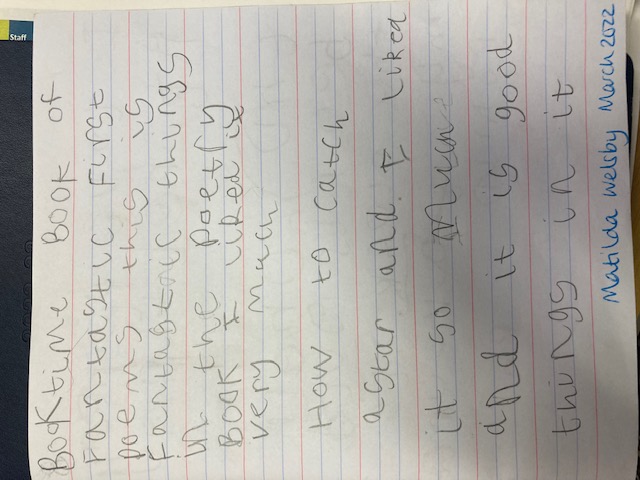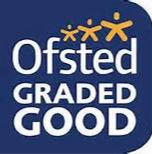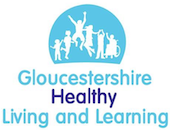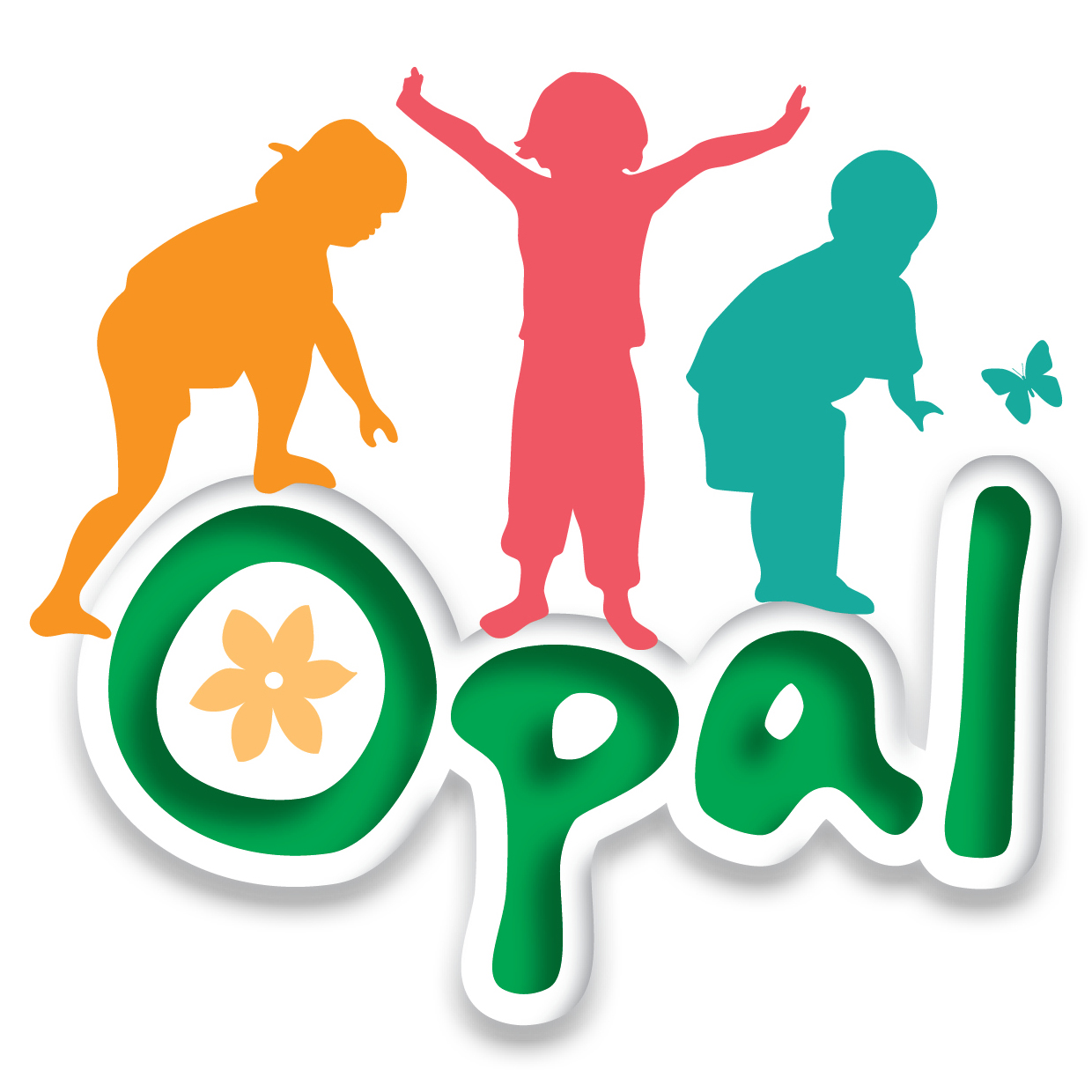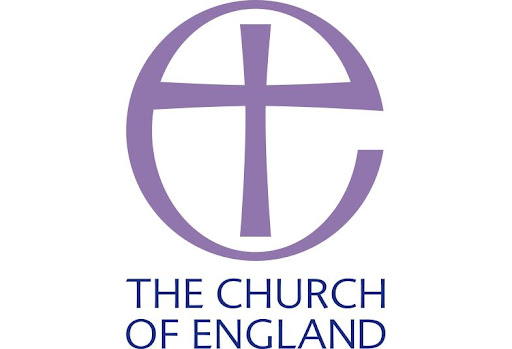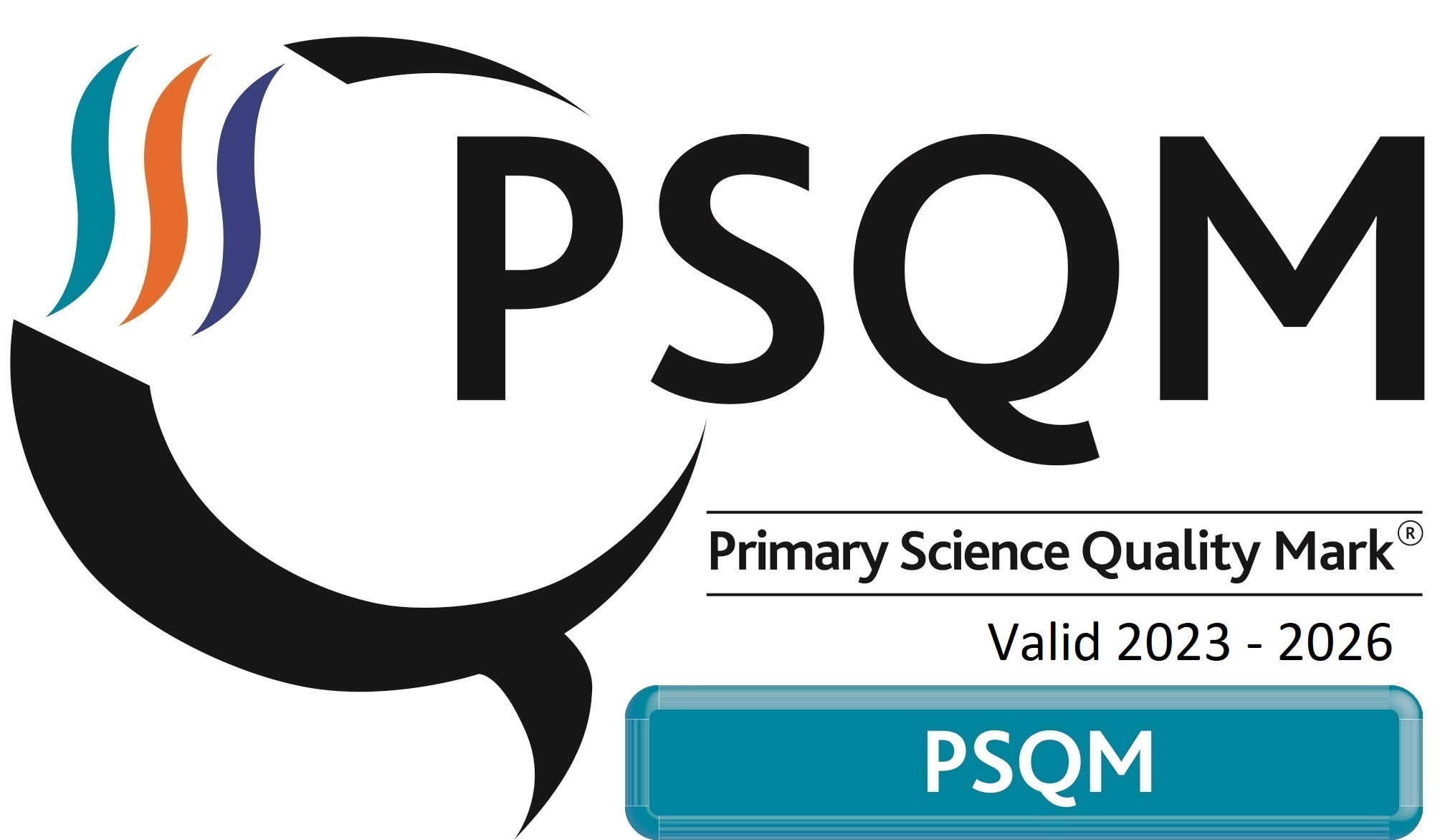Reading
Our reading curriculum supports children to foster a love of reading, learn independently by reading for information and learn the necessary skills to help their imaginations flourish. We aim to embed a culture where books, vocabulary and reading take priority, enabling children to become fluent and confident readers. We recognise how important it is to develop a passion for reading in our children, to enable them to be successful learners in all areas of the curriculum and in life beyond our school.
Phonics
In Early Years and Key Stage 1, the children are taught how to read using a synthetic phonics programme. Phonics is taught in five hour-long sessions each week in homogenous, fluid groups. We use 'ELS (Essential Letters & Sounds)' which is an engaging and rigorous approach to teaching early reading and writing.
ELS is a progressive phonics scheme which begins when children start school in Reception. Children work through the scheme of learning in a progressive manner until they can confidently read and understand a text.
The scheme also supports children’s writing by giving them the tools to spell and compose.
Synthetic phonics is a way of teaching reading. The children learn the sounds that written letters (or groups of letters) represent and how to blend them together to make words. There are 26 letters but they make 44 sounds.
Some words cannot be sounded out as they do not follow the phonics rule. Examples are 'the', 'into', 'buses, 'because'. Therefore these are taught as 'Harder to read and spell' Words within ELS. We teach them as sight words and the more children are exposed to them, the more they are instilled in their working memory.
Essential Letters and Sounds
Essential Letters and Sounds (ELS) is our chosen Phonics programme. The aim of ELS is ‘Getting all children to read well, quickly’. It teaches children to read by identifying the phonemes (the smallest unit of sound) and graphemes (the written version of the sound) within words and using these to read words.
Children begin learning Phonics at the very beginning of Reception and it is explicitly taught every day during a dedicated slot on the timetable. Children are given the knowledge and the skills to then apply this independently.
Throughout the day, children will use their growing Phonics knowledge to support them in other areas of the curriculum and will have many opportunities to practise their reading. This includes reading with a partner during paired reading and as a class.
Children continue daily Phonics lessons in Year 1 and further through the school to ensure all children become confident, fluent readers.
We follow the ELS progression and sequence. This allows our children to practise their existing phonic knowledge whilst building their understanding of the ‘code’ of our language GPCs (Grapheme Phoneme Correspondence). As a result, our children can tackle any unfamiliar words that they might discover.
Children experience the joy of books and language whilst rapidly acquiring the skills they need to become fluent independent readers and writers. ELS teaches relevant, useful and ambitious vocabulary to support each child’s journey to becoming fluent and independent readers.
We begin by teaching the single letter sounds before moving to diagraphs ‘sh’ (two letters spelling one sound), trigraphs ‘igh’ (three letters spelling one sound) and quadgraphs ‘eigh’ (four letters spelling one sound).
We teach children to:
- Decode (read) by identifying each sound within a word and blending them together to read fluently
- Encode (write) by segmenting each sound to write words accurately.
The structure of ELS lessons allows children to know what is coming next, what they need to do, and how to achieve success. This makes it easier for children to learn the GPCs we are teaching (the alphabetic code) and how to apply this when reading.
ELS is designed on the principle that children should ‘keep up’ rather than ‘catch up’. Since interventions are delivered within the lesson by the teacher, any child who is struggling with the new knowledge can be immediately targeted with appropriate support. Where further support is required, 1:1 interventions are used where needed. These interventions are short, specific and effective.
Supporting Reading at Home:
- Children will only read books that are entirely decodable, this means that they should be able to read these books as they already know the code contained within the book.
- We only use pure sounds when decoding words (no ‘uh’ after the sound)
- We want children to practise reading their book 4 times across the week working on these skills:
Decode – sounding out and blending to read the word.
Fluency – reading words with less obvious decoding.
Expression – using intonation and expression to bring the text to life!
We must use pure sounds when we are pronouncing the sounds and supporting children in reading words. If we mispronounce these sounds, we will make reading harder for our children. Please watch the videos below for how to accurately pronounce these sounds.
At the beginning of each academic year, we will hold an information session for parents and carers to find out more about what we do for Phonics, Reading and English at our schools. Please do join us.
More support for parents and carers can be found here:
https://home.oxfordowl.co.uk/reading/reading-schemes-oxford-levels/essential-letters-and-sounds/
https://vimeo.com/753929025/5eaa45c0aa
https://vimeo.com/753931102/b9a2f8194f
https://vimeo.com/753933192/43104a30e0
Reading at Home
At St Mary’s we want children to learn to read and read to learn. We encourage all our pupils to develop a lifelong love of reading.
We believe that the best way to become a fluent, confident reader is by practising. As with most things, practice makes perfect. Children need to read to an adult at home at least 3 times a week, (this is the minimum we ask). Re-reading the same book will help children to become more fluent, confident readers who can use their 'story teller' voice when they are reading out loud to make it engaging for the listener.
Reading books are carefully matched to a child’s reading ability. To begin with, children receive books without words and they are encouraged to describe what is happening in the pictures, predict what might happen next and to make a story of their own to match the pictures.
Once the children have learnt the majority of the single letter sounds they will be introduced to books with simple words to blend and read using their phonic knowledge. Once the children know all their single letter sounds and the first digraphs, (two letters which make one sound, sh, qu, ch, th, ng, nk, ck), they will progress onto books that contain those sounds. We then continue to teach the next set of digraphs (ay, ee, igh, ow, oo/oo, or, ou, air, oy, ar, ir) as when the children are ready. As they learn each new set they are then able to access the next level of reading book. We have carefully read each book to check which sounds they contain and have labelled them with our own banding system from lilac to black, to pink, to red and then finally yellow. They contain a mixture of books from different reading schemes but will ONLY contain the sounds your child has been TAUGHT (even if they have not yet retained all the sounds, they will be able to practice them in these books). Once your child has been taught all 44 sounds they can progress through the other colours in the reading scheme at the class teacher’s discretion. We ensure that reading books sent home are closely matched to the level of books children are reading in their phonics groups.
Children in Year 2, who have completed the ELS scheme and are proficient readers, are assessed and moved onto Accelerated Reader. If a child is not ready for this, they will remain on a phonically decodable book.
In Key stage 2, reading is taught in three guided reading sessions that are a balance between practising reading fluency, discussion based learning and written comprehension. In guided reading lessons, children learn the skills of reading, through VIPERS. VIPERS is an acronym, which aids the recall of the 6 reading domains from the reading curriculum (see below). These are the key areas that children need to know and understand in order to improve their comprehension of texts.
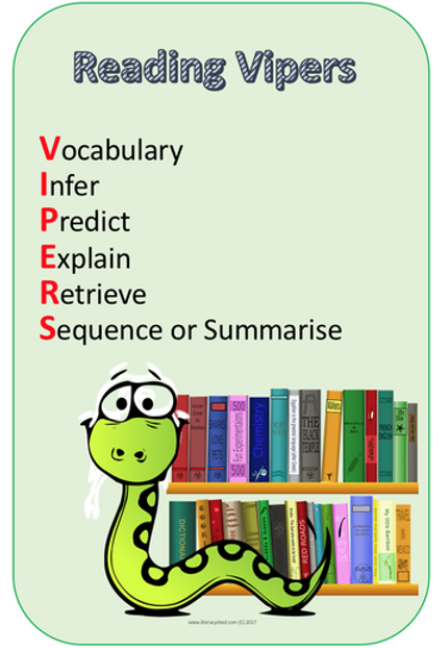
In guided reading lessons, children access high quality texts from a wide range of genres. These may be extracts from a class book (which is read every day), poems from our poetry spine or extracts from The Literacy Shed. Texts are carefully chosen to enrich pupils’ reading experience, whether they are reading fiction texts or reading for information and teachers make sure to identify links with other curriculum areas where appropriate. Pupils access one text per week answering VIPERS questions based on that text.
We also believe that teaching children to read fluently is vital since fluency is the bridge between word recognition and comprehension. Therefore, fluency is explicitly taught within Guided Reading sessions using a range of methods:
- Teachers activate pupils’ prior knowledge to ensure they understand the context of the extract. This helps to ‘set the scene’ in the children’s minds
- Teachers read the text aloud modelling expert prosody
- Pupils are encouraged to develop their own performance reading voice, emulating the teachers’ pace, pitch, passion, pause, power and use of punctuation. At St Mary’s we call these the ‘6Ps’
- The use of Echo reading where pupils practise reading trickier sentences or paragraphs after listening to the teacher
- Text marking where pupils annotate the text using agreed symbols which represent the 6Ps
- Pupils read the text with a response partner who offers feedback about what went well and what might be improved next time
In lessons, pupils are given time to read their extract multiple times aiming for greater fluency each time.
Reading Books
We use a variety of reading schemes to support children in their reading. The school recognises that whilst learning discrete reading skills is vital, children also need to develop a love of books and reading. The school builds time for children to read during the school day (DEAR- drop everything and read) and promotes reading at home. Every teacher in the school is an advocate for reading and sharing class books every day is a priority. As a school, we celebrate reading through events such as author visits, book groups, reading cafes and book recommendations. As well as this, children are regularly heard read aloud by an adult in EYFS/KS1 and as regularly as possible in KS2.
Children in year 2 to 6 follow Accelerated Reader-a reading management and monitoring programme that aims to foster independent reading. The programme assesses pupils’ reading age and gives them a ZPD code that helps pupils select books that offer appropriate challenge. Pupils take a computerised quiz once they have finished a book. Accelerated Reader provides immediate and regular feedback to children; allows teachers to make in depth, accurate assessments of children's reading and most importantly, helps foster a love of reading. Children are able to choose books within their level from beautiful classroom book corners, or our fantastic library. Parents are encouraged to extend the culture of reading into the home and are offered support in helping their children to read from a young age in phonics meetings that are held regularly.
For information on some of the books teachers use, please click here.
This KS2 reading guide gives some top tips to help you enjoy reading with your child at home.
We also hold regular 'Breakfast with a Book' events where parents, carers, grandparents and friends can share a book with the children whilst enjoying a cup of tea and a croissant. Please keep a look out for the next date which will be announced in the reading newsletter.
Reading Newsletter December 2022
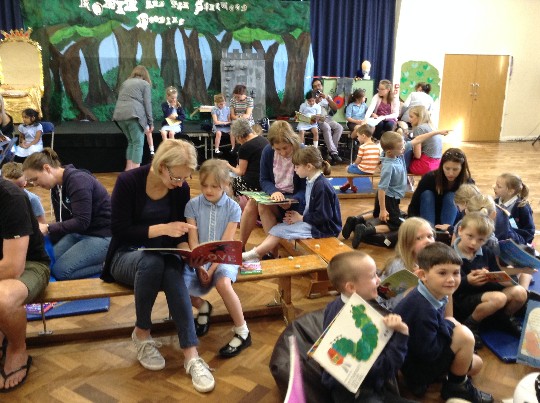
The Reading Shed
We are delighted that our Reading Shed is now open! All children have access to the Reading Shed which is open at breaktimes and looked after by our wonderful Reading Ambassadors.
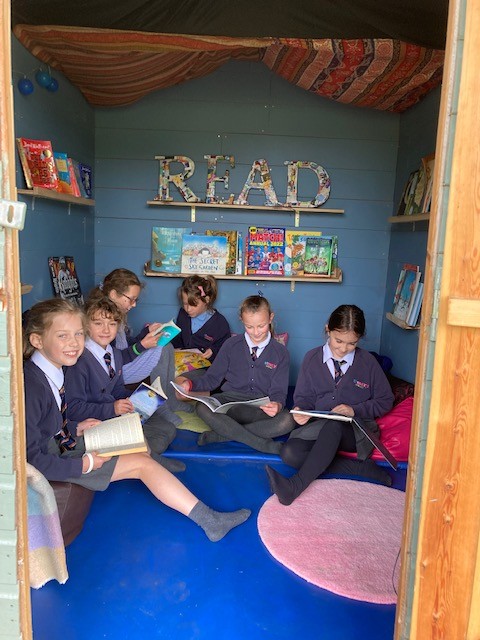
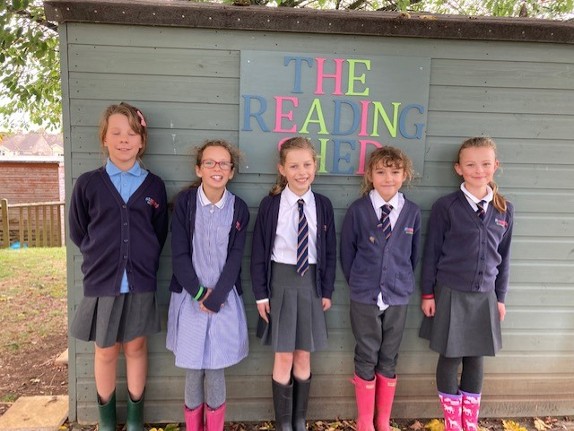
In EYFS, children take it in turns to take home the Red Reading Suitcase and read to Percy the dog. The suitcase contains several beautiful reading books,

Percy(our very cuddly reading dog who loves stories) and sachets of hot chocolate. Children love sharing these stories and enjoy drawing pictures about what they have read in the reading diary.
